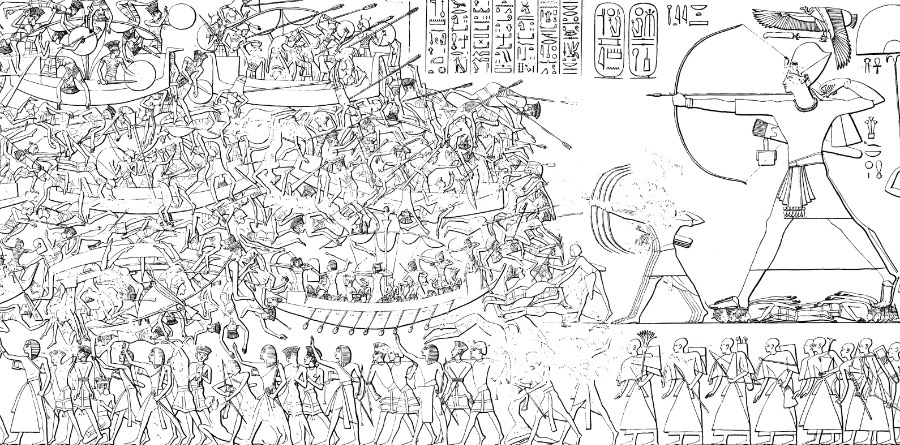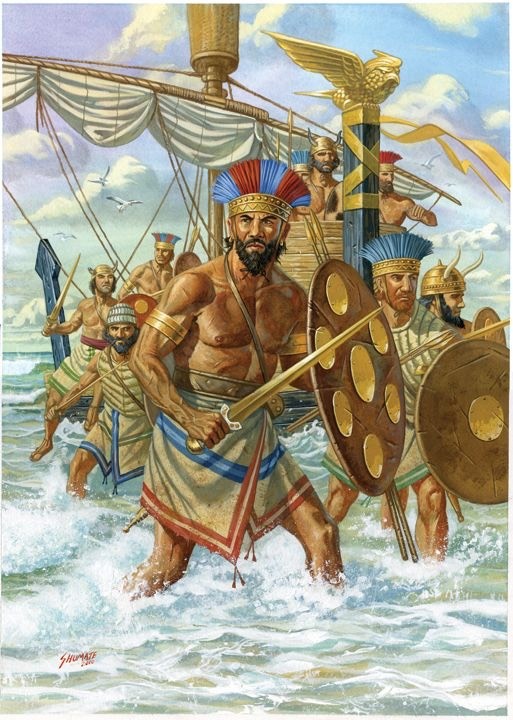November 2nd, 2012
Towards the end of the second millennium BCE (that is, around 1200 BCE), two things happened that changed everything. The first was the development of a new kind of rigging called “brailing line”. Prior to that, sails were rectangular and hung down from a yard (a long horizontal wooden pole tied to the mast) and attached to a boom (a second horizontal pole tied to the base of the mast). Sailors could raise the yard to make sail or lower it in countervailing winds. They could rotate the sail horizontally to get somewhat better response to wind that wasn’t coming from directly behind, but they didn’t get a lot of benefit from this.
Brailing was a system of ropes stretching down from the yard; each rope could be individually tightened or loosened, giving the sailors greater flexibility in shaping or tilting the sail. This in turn permitted better performance in winds that weren’t coming from directly behind. The resulting improvement wasn’t revolutionary, but it certainly helped.
At roughly the same time, a catastrophe descended upon the entire Middle East. A horde of invading barbarians called the “Sea Peoples” swept over the area. They destroyed the Hittite Empire, wiped out the Mycenaeans on Greece and Crete, obliterated the major trading center of Ugarit (near the corner of the Mediterranean where Turkey meets Syria) and otherwise behaved in a generally discourteous way. The Egyptians just barely repelled their invasion. This wasn’t just a single invasion; apparently the Sea Peoples sailed all over the Eastern Mediterranean, killing, burning, and looting everywhere. Think of them as the Vikings of the Bronze Age.

Battle between Egyptians and Sea People

Artist’s idea of what they might have looked like
There’s plenty of scholarly controversy about exactly what happened and how it happened. It seems that the process was extended over many decades; instead of massive armies and navies sweeping through the land and sea, conquering everything in sight, it was more likely a matter of nomadic raiders in huge numbers subjecting civilized peoples to constant destructive raiding that eventually brought everything tumbling down. On top of this, there is evidence of major earthquakes as well as popular rebellions, possibly driven by drought. Scientists have now established the climate change also played a role by reducing rainfall over much of the area. These were definitely Bad Hair Centuries.
The one-two-three-four blows of the Sea Peoples, earthquakes, rebellions, and climate change destroyed everything along the eastern coast of the Mediterranean. Their depredations weakened Egypt, and may have been responsible for the Pharaoh letting go a tribe of griping dissidents called Hebrews. Populations declined precipitously, especially in the Aegean area.
One factor that seems significant to me is the naval superiority of these people. The Egyptians were able to trap and destroy a Sea Peoples fleet in one notable battle, but for the most part, the Sea Peoples seemed to have been able to come and go as they pleased, suggesting that they possessed superior naval technology. Brailed rigging might have been part of it.
The Sea Peoples wiped the slate clean. Civilization was decimated; the population in the Aegean plummeted. This set the stage for the most remarkable and momentous series of developments in human history.
[February 14th, 2021] Since I wrote this essay, paleoclimatology has progressed and has enabled scholars to determine that a change in climate in the Near East led to prolonged drought that would have proven catastrophic to civilizations in that area. Accordingly, the Sea Peoples may well have been a symptom of climate change, with drought being the primary causal factor in the Bronze Age Collapse.
